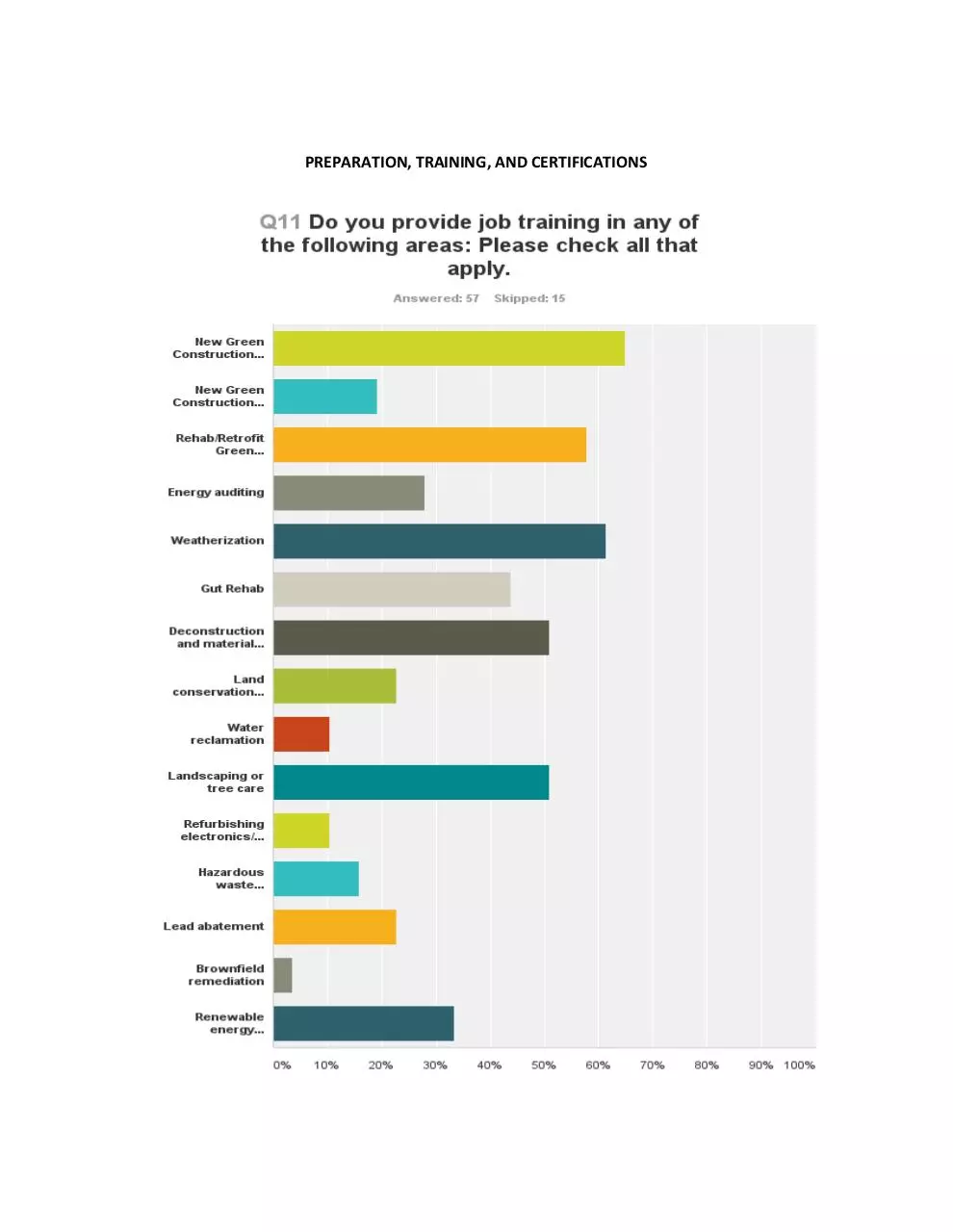2014 NATIONAL SURVEY SUMMARY (PDF)
File information
Author: Allee Rosenmayer
This PDF 1.5 document has been generated by Microsoft® Word 2010, and has been sent on pdf-archive.com on 18/03/2015 at 14:14, from IP address 209.113.x.x.
The current document download page has been viewed 475 times.
File size: 698.4 KB (12 pages).
Privacy: public file





File preview
2014 NATIONAL SURVEY
SUMMARY AND OVERVIEW
PROGRAMS
72 completed
This represents approximately 27% of the entire YouthBuild network and 35% of the YouthBuild USA
Affiliated Network.
PARTNERSHIPS AND FUNDING
72% of programs are partnered with a community college; an 11% decreased from 2011 data
64% are partnered with city, town, or county agency; 42% get funding from that partner; a 15%
decrease from 2011 data
57% are partnered with a Workforce Investment Board
57% are partnered with a career one-stop center
51% are partnered with a housing authority
46% are partnered with employers for construction and/or green jobs
No other partners were reported as significant funders.
27 programs received weatherization funding and/or subcontracting work through a community, state,
or WAP program. This is a 6 program increase from 2011 data collected.
53% of respondents have approached their housing authority to be included in renovation work or to
employ graduates. With 51% of programs reporting a partnership with their local housing authority, this
indicates an incredibly high success rate for these approaches.
51% generate revenue from construction teams working on a fee for service basis (an 18% increase from
2011); of these, working on a fee for service basis; of these, 35% are focused on green building. Several
programs have found their own ways to generate revenue; these include building sheds and picnic
tables; a product line of garden materials; deconstruction and recycling sorting; manufacturing
advanced energy panels; building materials re-use store. Several programs generate revenue through
weatherization and related activities.
A few comments illustrate a general response pattern:
Our partnerships with construction unions and apprenticeship programs have increased the
prestige of pre-apprenticeship programs but have generated limited funding. We get a lot of inkind support from union apprenticeship programs and home performance contractors. - Bill
Kowalczyk, Portland YouthBuilders
You have to start with what your goal/plan is and then figure out how to piece together funding
to support the goal. Also, in the plan, it is important to find a way to prove you have the
capacity/skills. - Jennifer Lawrence, YouthBuild Schnectday
PREPARATION, TRAINING, AND CERTIFICATIONS
64% provide job training in residential green construction.
61% of respondents provide job training in weatherization (a 10% decrease from 2011).
58% provide job training in rehab and retrofitting.
Approximately 40% provide job training in the following areas: energy auditing; energy retrofit; gut
rehab; deconstruction and material re-use; and landscaping or tree care.
75% are preparing their students for OSHA certification. This is a 6% increase from 2011.
47% are preparing their students for NCCER and 50% for HBI certifications.
17-30% are preparing their students for BPI certifications, labor union trainings, Green Advantage,
and/or EPA RRP/Lead Safe. (5% increase from 2011).
68% have instructors with HBI certification. This is an 11% increase from 2011.
63% have instructors with OSHA certification. This is a 13% increase from 2011.
56% have instructors with NCCER certification. This is a 10% decrease from 2011, making it be the only
certification that has decreased in use as reported by programs.
38% of respondents would like to add LEED certification – currently, only 7% of students are being
prepared for it, and only 8% of instructors are certified in it. LEED was the most desired certification to
add.
Smaller percentages (25-35%) would like to add BPI, Green Advantage, MC3, and/or EPA RRP/Lead Safe
certifications.
50% of programs are using NCCER curricula.
55% are using HBI curricula.
These were the most significant curricula in place.
CAREER DEVELOPMENT AND PLACEMENT
45% of programs said their graduates can find employment related to their green training; this is a 4%
increase from 2011.
54% said they cannot, which is a 5% decrease from 2011. Selected comment:
We have found limited employment opportunities in "green jobs". The home performance
market was hard hit by falling gas prices and installing insulation attracted few students.
However, green training made our student well informed when entering any of the traditional
trades or non-union residential construction because green construction practices are ubiquitous.
This background enhances their job or apprenticeship applications. – Bill Kowalczyk, Portland
YouthBuilders
Some examples of Green Jobs reported:
Solar Panel Installation Worker, various companies, average starting pay rate of $14/hour. –
MAAC YouthBuild
Solar Installers, starting at $12 and up; Solar Crew Leaders $16+, Insulation Installers $12+ YouthBuild Schenectady
Deconstruction Workers (entry level is $10/hour) - SER YouthBuild Construction Institute
Insulator Apprentice, Conservation Specialty Insulation, $18.00/hour- UCS YouthBuild
38 programs said employers are looking to hire for landscaping jobs, with 30 programs saying employers
are looking in the area of green construction and 32 said weatherization.
An interesting finding is that 26 programs responded ‘yes’ to the question “Do you know of any
YouthBuild graduates who own or operate their own business, or who would like to?” Follow-up
remains to be done with these programs to assess the nature of these businesses.
53 of the programs who submitted the survey said they coach students to including green job skills on
their resumes/portfolios.
Further comments on career development and placement:
It is important to give real life experience and to coach young people on these careers as "best
bets" since they are not careers that are easy to conceptualize. – YouthBuild Schenectady
Our experience is that the structure of apprenticeship provides the best longer term
opportunities for our students. – Portland YouthBuilders
Green jobs are limited in our areas so it is a challenge to employ participants in this specific area.
The students in our program receive the NCCER: Your Role in the Green Environment training for
green building skills. – YouthBuild of the Pineywoods
We find that weatherization certs and green construction skills are useful in helping participants
find related employment even if the position they get isn't solely focused on that type of work.
Contractors in our small area tend to do a wide range of projects and having staff with multiple
credentials and skills is valuable to them. – CSC YouthBuild
GREEN BUILDING PRACTICES
71% of programs do not have their construction rated by an outside agency; this is a 10% increase from
2011.
The most common green building practices are as follows (all are within a 5% range from 2011):
Use recycled content building materials – 58%
Install Energy Star appliances and/or windows – 75%
Install water heaters within 30 feet of bathrooms and kitchens – 53%
Install ultra-low-flow toilets – 53%
Use low-VOC paints and sealants – 48%
Provide information to the occupants on care and use of the home – 47%
For the low-hanging fruit that these measures represent, these are quite low numbers. Energy Star again
figures big in program’s practices.
Programs do have other green practices in place on an individual level; recycling appears to be the most
common.
A few comments on green building practices:
All metal scrap, cardboard and paper is recycled. The stud layout is 24" on center to reduce
material use. All wood scraps are saved and donated to people with wood burning stoves. No
interior flooring downstairs, we do slab floors with radiant heat. – Santa Fe YouthWorks
We aspire to write up a "Green Sheet" on all our projects which identify the green characteristics
that are incorporated in the construction practices. This is the basis of the hands-on component
of our green construction curriculum. – YouthBuild Newark, Newark NJ
ENVIRONMENTAL LEADERSHIP
67% of programs teach the “why” of green building.
78% have students and/or graduates participating in green community service projects.
Download 2014 NATIONAL SURVEY SUMMARY
2014 NATIONAL SURVEY SUMMARY.pdf (PDF, 698.4 KB)
Download PDF
Share this file on social networks
Link to this page
Permanent link
Use the permanent link to the download page to share your document on Facebook, Twitter, LinkedIn, or directly with a contact by e-Mail, Messenger, Whatsapp, Line..
Short link
Use the short link to share your document on Twitter or by text message (SMS)
HTML Code
Copy the following HTML code to share your document on a Website or Blog
QR Code to this page

This file has been shared publicly by a user of PDF Archive.
Document ID: 0000215885.